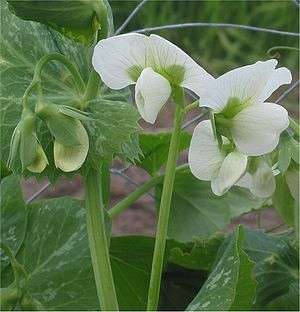| Peas | |
|---|---|
 | |
| Genus: | Pisum |
| Family: | Fabaceae |
| Type: | Annuals |
| Pollination: | Insects |
Pisum is a genus of the family Fabaceae, native to southwest Asia and northeast Africa. Pisum sativum, the field pea or garden pea, is the most commonly cultivated.
Description
Tendrilled vines with compound leaves. The flower has 5 sepals (fused), 5 petal, 10 anthers (9 are fused ,1 free) and 2 carpels(fused). The fruit is a legume (the pea).
Growing conditions
Sunny locations, soils should be rich but well-drained. Seeds are usually inoculated with a bacteria which fixes atmospheric nitrogen for the use of the plant.
Varieties
The genus contains one to five species, depending on taxonomic interpretation; the International Legume Database (ILDIS) accepts three species, one with two subspecies :
- Pisum abyssinicum (syn. P. sativum subsp. abyssinicum)
- Pisum fulvum
- Pisum sativum - Pea
- Pisum sativum subsp. elatius (syn. P. elatius, P. syriacum)
- Pisum sativum subsp. sativum
Uses
Pisum sativum is commonly grown as a food crop, but all plants in this genus can be used as cover crops.
Pests and diseases
Leaf Spot, Pod Spot
- Ascochyta pinodes
- Ascochyta pisi
Damping Off
White Mold
- Sclerotinia sclerotiorum
Root Rots
Wilt
- Fusarium oxysporum pisi
- Pea Aphid: Acyrthosiphon pisum
- Green Peach Aphid: Myzus persicae
- Tarnished Plant Bug: Lygus lineolaris
- Fourlined Plant Bug: Poecilocapsus lineatus
- Onions thrips: Thrips tabaci
- American Serpentine Leafminer: Liriomyza trifolii
- Pea Leafminer: Liriomyza huidobrensis
- Seedcorn Maggot: Delia platura
- Pea Weevil: Bruchus pisorum
- Pea Leaf Weevil: Sitona lineatus
- Cucumber Beetles
- Turnip Moth: Agrotis segetum
- Pea Moth: Cydia nigricana
- Stalk Borer: Papaipema nebris
- Cabbage Looper: Trichoplusia ni
- Celery Looper: Anagrapha falcifera
- Speckled Green Fruitworm: Orthosia hibisci
- Beet Armyworm: Spodoptera exigua
Bucculatrix pyrivorella, w:Cabbage Moth, Common Swift, w:Ghost Moth, Hypercompe indecisa, The Nutmeg, w:Setaceous Hebrew Character and w:Turnip Moth.
References
Christopher Brickell et al. (1993). The American Horticultural Society Encyclopedia of Gardening. DK Publishing, inc.. pp. 339-340.
- Staff of the L. H. Bailey Hortorium (1976). Hortus Third: A Concise Dictionary of Plants Cultivated in the United States and Canada. Cornell University Press. pp. 879.
- Cranshaw, Whitney (2004). Garden Insects of North America: The Ultimate Guide to Backyard Bugs. Princeton University Press. pp. 613.
- Pippa Greenwood, Andrew Halstead, A.R. Chase, Daniel Gilrein (2000). American Horticultural Society Pests & Diseases: The Complete Guide to Preventing, Identifying, and Treating Plant Problems (First Edition ed.). Dorling Kindersley (DK) Publishing, inc.. pp. 203.